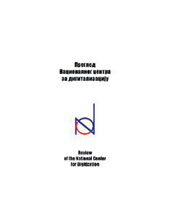Issues
Review of the National Center for Digitization
Publisher: Faculty of Mathematics, University of Belgrade
ISSN: 1820-0109
Issue: 43
Year: 2023

TWENTY YEARS OF VIRTUAL LIBRARY OF MATHEMATICAL FACULTY IN BELGRADE
Žarko Mijajlović
Keywords: virtual library, electronic editions, history of science
1 - 7
DIGITIZATION OF THE MANUSCRIPT HERITAGE OF THE COMPOSER VELIMIR SPERNJA
Monika Novaković and Teodora Trajković
8 - 19
DIGITIZED BULLETIN LUNJINA SERBIAN AROMANIAN SOCIETY
Maja Nikolova
Keywords: Aromanians, education, Lunjina, tradition, digitization.
20 - 27
THE WAR MEMORIALS IN THE MUNICIPALITY OF CRNA TRAVA
Zoran Cvetković
Keywords: First World War, Second World War, Serbia, terror, war victims, monuments.
28 – 43
COLLECTIONS OF ASTRONOMICAL PROBLEMS IN SERBIAN
Sonja Vidojević and Vera Prokić and Slobodan Ninković
Keywords: astronomy contests, collections of problems.
44 – 49
RECORDS IN THE SKY CIRRUS HOMOGENITUS AND CIRRUS HOMOMUTATUS
Nedeljko Todorović
Keywords: aircraft tracks, meteorological conditions, cloud atlas.
50 – 58
ENN TYUGU: SOCIAL AND PROFESSIONAL BACKGROUND
Irina Krayneva and Merik Meriste and Killu Sanborn
59 – 68
COMMUNICATION WITH AI, COMMUNICATION BETWEEN AIS – FIELD TESTS
Aleksandra Fostikov
Keywords: Bing, ChatGPT 3.5 (Chat Generative Pre-Trained Transformer), communication, civilization Artificial Intelligence (AI), Digital Humanities (DH), Perplexity, “sentient”, society.
Supplementary file 1: COMMUNICATION WITH AI, COMMUNICATION BETWEEN AIS – FIELD TESTS
Supplementary file 2: Communication with Perplexity
69 – 77
AN ITALIAN-SERBIAN SENTENCE ALIGNED PARALLEL LITERARY CORPUS
Saša Moderc and Ranka Stanković and Aleksandra Tomašević and Mihailo Škorić
Keywords: Aligned corpus, parallel corpus, Serbian, Italian, literature.
78 – 91
SHANGHAI WORLD RANK LIST OF THE REGION IN 2023
Gyula Mester
Keywords: Academic Ranking of World Universities, ARWU 2023, six objective indicators and weights for ARWU.
92 – 97